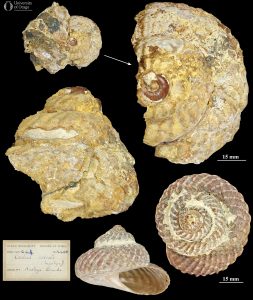43 An intertidal gastropod from the alpine zone
Molluscs, Gastropoda: Cookia cf. sulcata
Marine fossils occur in surprising places in New Zealand and can provide important benchmarks with respect to changing sea levels, the position of paleo-coastlines and even tracking rates of tectonic uplift over time.
One of the more remarkable fossils on display in the Geology Museum is the gastropod snail known as Cookia which was collected with a range of other intertidal animals from a fossil locality more than 1000 m above sea level on the upper slopes of Mt Luxmore, in Fiordland National Park. Comparison with a modern Cookia shows surprisingly little change in external morphology over 25 million years, although it is different enough to need a new species name.

Vertical and side views of a specimen of Cookia collected from a conglomeratic breccia on the upper slopes of Mt Luxmore, Fiordland, still partly embedded in the rock matrix. Lower right, for comparison, are two views of a modern specimen washed up on Katiki Beach (labelled Kartigi on the old School of Mines label), north of Palmerston in the 1930s. Image credit: JH Robinson
Distinguished by a solid conical shell with diagonal ribs, Cookia is a common inhabitant of the intertidal zone all around New Zealand, and specimens commonly wash up on beaches after a storm. Living under stones and on the underside of rocky ledges, Cookia is mostly restricted to environments ranging from intertidal to depths of 10 m. Like other members of the Turbinidae family, Cookia has a solid, tightly fitting operculum which keeps the animal from becoming desiccated and also deters potential predators.
The Cookia fossil, together with other rocky shore inhabitants such as Trochus (Thorista), a poorly preserved but distinctive Haliotis (pāua), and an operculum from a turbinid, were collected from a fossil locality that is today 1310 m above sea level. Using the paleo-coastline as a spirit level demonstrates that more than 1300 m of uplift has taken place along the eastern margin of Fiordland, mostly between 11 and 3 million years ago.
Cookia sulcata, sometimes called Cook’s turban shell, is named after Captain James Cook whose crew members collected specimens of many different marine animals from New Zealand during their voyages between 1769 and 1773. Taken back to England, the type specimen was initially given the species name Trochus sulcatus by Gmelin in 1791 and placed in the new genus Cookia by Lesson in 1832. [It is interesting to note that James Cook and his crew were anchored off the west coast of Fiordland for 5 weeks during 1773].
The 25 million-year-old fossil closely resembles modern Cookia sulcata, though the ribs are broader and traces of the nacreous shell layer beneath the worn exterior are still visible. Rarely is it possible to associate fossils with their likely food source, but living Cookia are known to graze on coralline algae, the “pink paint” seen in rock pools, and such calcareous algae are present at the Mt Luxmore fossil locality.
– Written by Daphne E Lee and Jeffrey H Robinson
| Specimen number: OU 12045 | Age: Approximately 25 million years (late Oligocene, Duntroonian or Waitakian stage)
|
| Locality: Eastern ridge of Low Peak, Mt Luxmore, Fiordland National Park | Rock Formation: Fossiliferous conglomerate |
| Collected by: John R. Sise, 1976 | |
| Citation: Lee, D.E., Carter, R.M., King, R.P. & Cooper, A.F. 1983. An Oligocene rocky shore community from Mt Luxmore, Fiordland. New Zealand Journal of Geology and Geophysics 26: 123‑126. |

